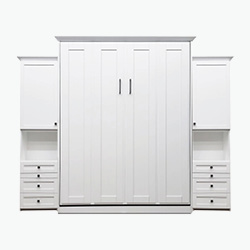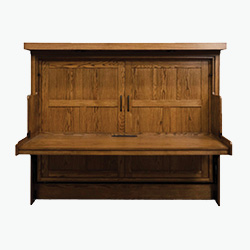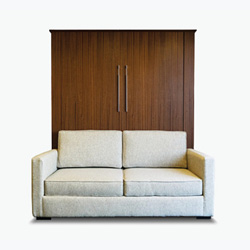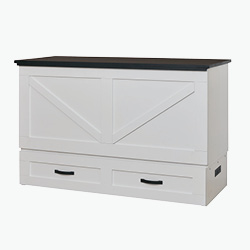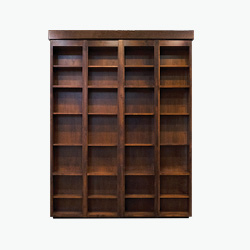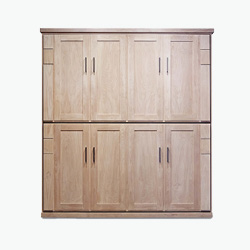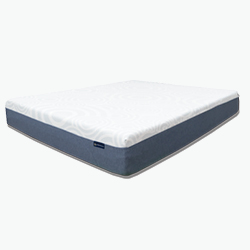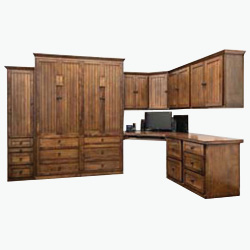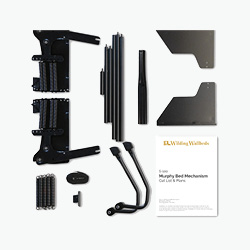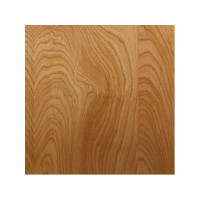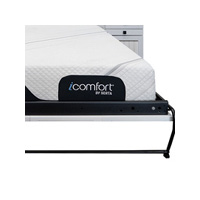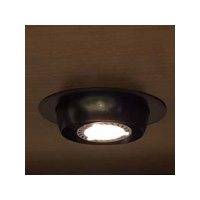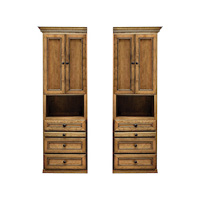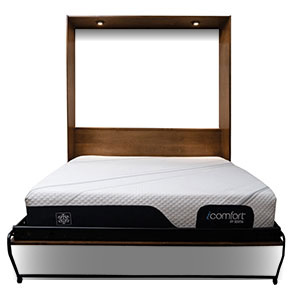What’s the Difference Between a Murphy Bed and a Wall Bed?
While the two terms have grown to become almost interchangeable, if you look a little deeper you’ll find that there really are differences between the two space-saving beds. Learn more about what makes each option unique and how to decide which is right for you.
If you search online for a Murphy bed you’ll see many space-saving, bed-hiding products that could help transform your room. There are Murphy beds, wall beds, desk beds, cabinet beds, and bookcase beds, to name a few. With all of these various products available, it can be tricky to decide which product will be best for your space. A few of the first questions that may pop into your head as you begin your research are: what is the difference between a Murphy bed and a wall bed? Are they synonyms? Which one will work best for my space? The truth is that there are many people, even supposed ‘Murphy bed experts’, who actually don’t know the difference between the two. This is partly because, over time, the two products have evolved into very similar products with only a few key differentiations.
So, what is the difference between a Murphy bed and a wall bed? Put simply, the differences are in the lifting mechanisms and the construction of the frame that holds the mattress. Murphy beds use springs to help lift and lower the bed while wall beds typically use pistons. Further, Murphy beds are typically built with a metal bed frame where wall beds are built with a wood frame and mattress surrounds. There are also some wall beds that don’t use any type of lifting mechanism, but these cheap alternatives aren’t recommended as they require at least two able-bodied adults to lift and lower the bed–hope you’ve been spending some time at the gym!
To understand how Murphy beds and wall beds are currently classified, it’s necessary to go back in time to their origins. This is because, over time, they have morphed and evolved, becoming more and more similar and more and more difficult to differentiate. When you look at the first Murphy bed and the first wall bed, they have drastic differences that are easily compared.
Murphy Beds Origin Story
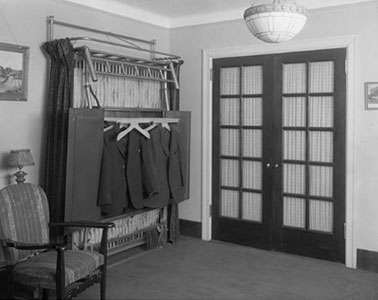
Maybe you have heard the quaint story of the invention of the Murphy bed already. It was the late 1800’s in San Francisco, CA. A gentleman by the name of William Lawrence Murphy was in a bit of a bind. You see, at the time, it was against the commonly held social mores to allow a member of the opposite sex into your bed chambers. This put quite the damper on William’s dating life because he lived in a tiny studio apartment in the city.
William was dating an opera singer whom he quite liked, but he could not, in good conscience, allow her into his apartment. This is when he had a stroke of genius: if he could fold his bed into his closet when he had a lady over he could both entertain a woman in his apartment and remain honorable in the community. Eventually, he developed and patented the original Murphy beds: a contraption fabricated out of a metal bed frame that used door hinges to fold into his closet on-demand.
Wall Beds Origin Story
The origins of wall beds are more vague and certainly less anecdotal. At some point in the late 20th century, cabinet builders decided, rather than using up closet space, they could build a cabinet that would house a mattress, allowing it to cantilever out into the room when it was needed. This cabinet was mounted on a wall, rather than inside of a closet, hence the name “wall bed” came into use.
These beds could produce all of the functionality of a Murphy bed without needing a spare closet. They were also designed more like furniture, with the freedom to build a gorgeous cabinet rather than an unsightly conglomeration of steel and squeaky springs. Since their inception, wall beds have most commonly used gas-charged pistons (bigger, stronger cousins of the pistons that help you open your car trunk, for example.) to help lift and lower the bed. These pistons can effectively reduce the amount you have to lift to 20-30 lbs. rather than the actual weight which is more than 100 lbs..
So What’s the Difference?
As you compare “Murphy bed 1.0” with “wall bed 1.0”, as outlined above, can you see the differences? Murphy beds were spring-driven metal frames designed to be hidden in a closet whereas wall beds were piston-driven wood cabinets designed to be mounted anywhere in a room. Now that we’ve cleared that up, let’s muddy the water a little, shall we?
As previously mentioned, Murphy beds and wall beds have grown increasingly similar through the years. This is due mostly to an evolution in Murphy beds, while wall beds have remained basically unchanged. Murphy beds have gradually evolved from closet-dwelling contraptions to cabinetry similar to wall beds. It’s almost as if Murphy bed manufacturers recognized the aesthetic gap between their products and a nice all-wood wall bed and they began producing wood-based versions of their beds to compete.
Today, the terms ‘Murphy bed’ and ‘wall bed’ are nearly synonymous, but there are still differences that serve as throwbacks to their original designs–Murphy beds still tend to use a metal frame with springs where wall beds are built from wood and use an alternative lifting system, usually pistons. Are there some companies that have spring-driven wall beds? Probably. Are there some companies that have pistons with a metal frame? Most likely. But, on average, the differences mentioned above tend to hold true.
Wall beds vs. Murphy beds
Wall beds
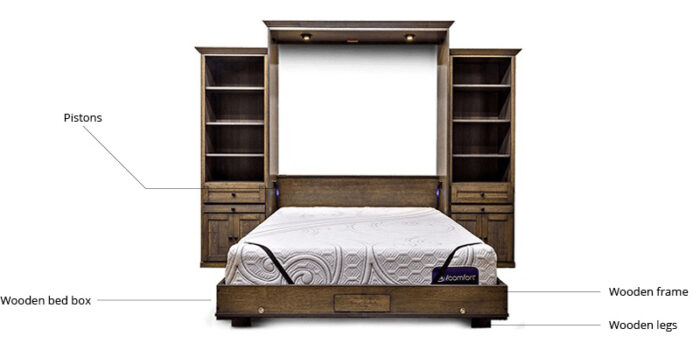
Murphy beds
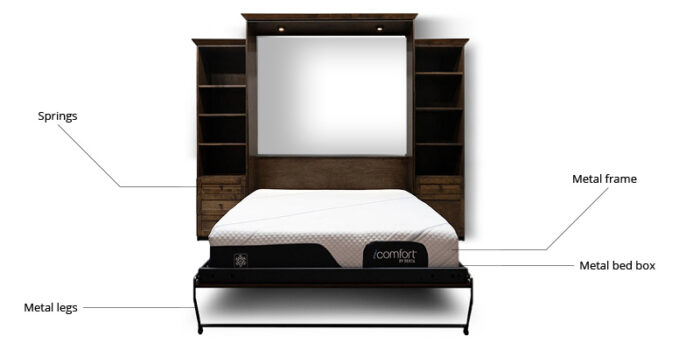
Which Should I Choose?
Now that you know how to classify wall beds and Murphy beds, here comes the important question: which one is better? The answer to that question is not simple and cut-and-dry and it really depends on your needs and preferences. Here’s a more in-depth guide to this question, but there are a few points to note.
Construction materials
Before analyzing the differences between Murphy beds and wall beds, the very first thing you should look for is a real wood product. Some companies build Murphy beds and wall beds out of inferior wood alternatives like particle board. We get calls routinely from customers who purchased a cheap Murphy bed which has broken and they are trying to find somebody to repair it. The mechanisms that power these beds use extreme amounts of stored energy and particle board and other cheap wood alternatives just don’t cut it.
Weight Limits
Both wall beds and Murphy beds have more-than sufficient weight limits. For example, at Wilding Wallbeds, our all wood wall beds have been tested to 4,000 lbs. and our Murphy beds have been tested to 2,500 lbs.. In either case, unless you are looking to park your car on your bed the difference is inconsequential.
Assembly
When considering the differences in assembly there are some pros and cons to consider. Wall beds are shipped partially assembled, which means the assembly time is typically 1-2 hours. Murphy beds, on the other hand, ship broken-down and require 3-4 hours to assemble. However, because Murphy beds ship broken down, the heaviest piece to lift and maneuver is typically about 30 lbs. compared to 100+ lbs. on a wall bed. So, if you are going to be lifting this bed up multiple flights of stairs, through tight corners, or on a small elevator, a Murphy bed is probably the right way to go.
Style
Both wall beds and Murphy beds offer attractive style options, so you are sure to find a style that you love either way. To highlight a couple of the differences, it should be noted that some customers take issue with the wooden legs that are visible on the face of wall beds. These legs are usually hidden within the design and style of the bed, but they are still visible. On the other hand, Murphy beds have drastically more metal components visible when the beds are in use, which some consider to be unsightly.
Sizes
The vast majority of Murphy beds or wall beds sold are queen size. However, depending on individual needs and space availability, sometimes other sizes are necessary. Wall beds are usually available in twin, twin xl, full and queen sizes. Murphy beds are usually available in twin, twin xl, full, queen, and king sizes. So, if you need a king size bed, you will want to find a Murphy bed you like.
Comparing Wilding Wallbeds Murphy beds and wall beds*
| Criteria | Wall beds | Murphy beds |
|---|---|---|
| Mechanism | Gas piston | Springs |
| Weight capacity | 4,000 lbs | 2,500 lbs |
| Warranty | Lifetime | Lifetime |
| Assembly time | 1-2 hours | 3-4 hours |
| Heaviest individual component | 100+ lbs. | 30 lbs. |
| Style | All wood face, exposed legs when closed | All wood face, exposed metal frame when open |
| Comfort | Depends on mattress used | Depends on mattress used |
| Projection while in use (queen size) | 84″ | 90″ |
| Size available | Up to a queen | Up to a king |
